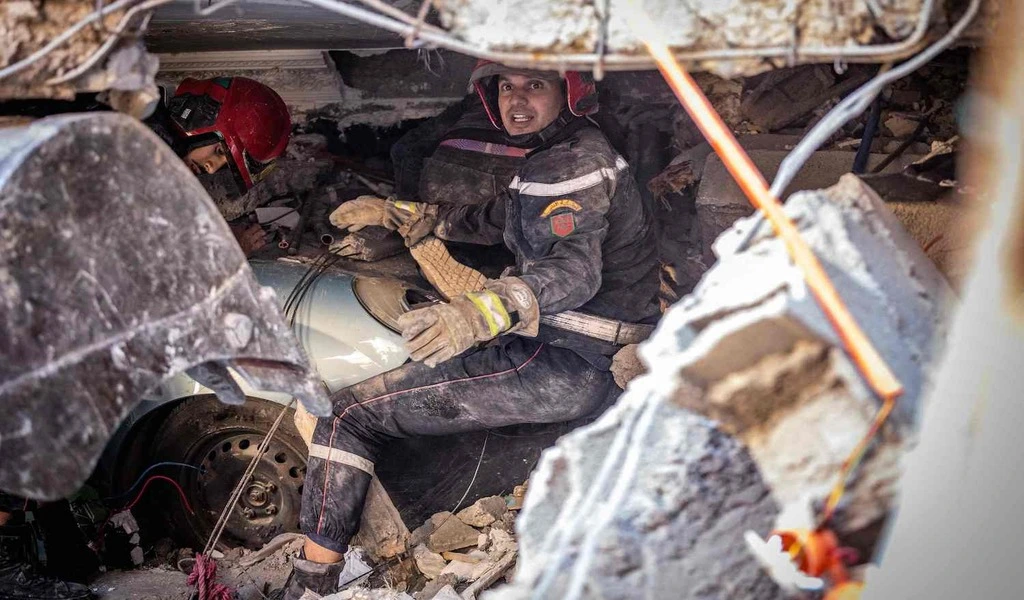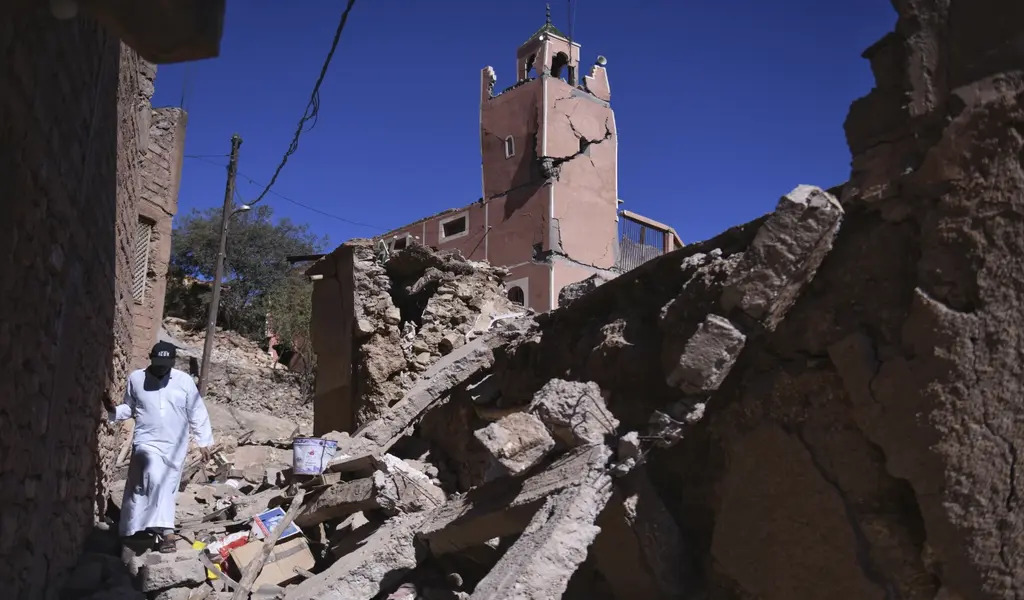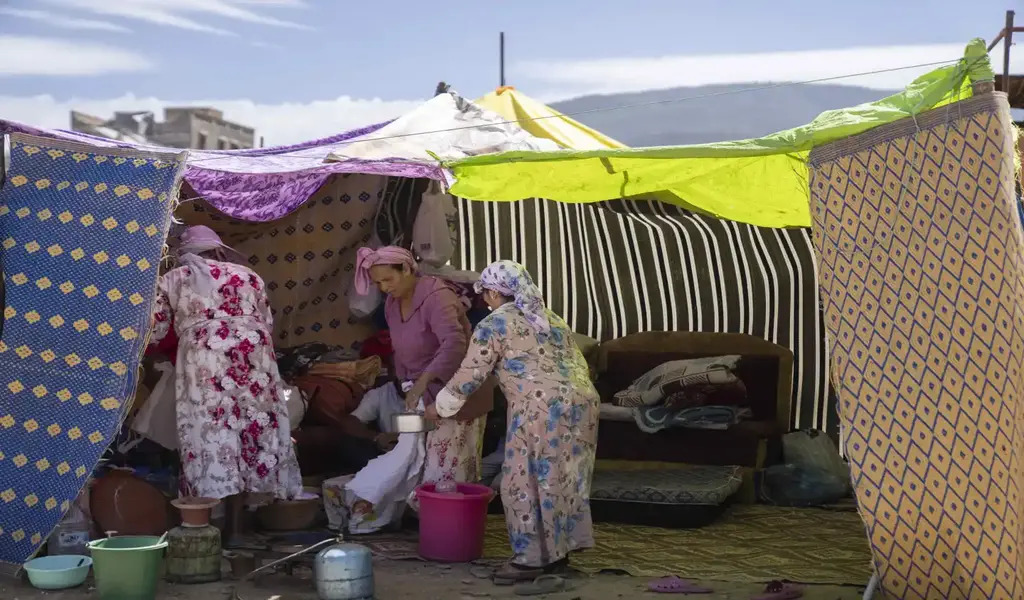News Video
United States Deports 95 Year-old Former Nazi Camp Guard to Germany
NEW YORK – The last Nazi war crimes suspect facing deportation from the U.S. was taken from his New York City home and spirited early Tuesday morning to Germany, following years of efforts to remove him from the United States.
The deportation of the 95-year-old former Nazi camp guard, Jakiw Palij, came 25 years after investigators first confronted him about his World War II past and he admitted lying to get into the U.S., claiming he spent the war as a farmer and factory worker.
Palij lived quietly in the U.S. for years, as a draftsman and then as a retiree, until nearly three decades ago when investigators found his name on an old Nazi roster and a fellow former guard spilled the secret that he was “living somewhere in America.”
Palij told Justice Department investigators who showed up at his door in 1993: “I would never have received my visa if I told the truth. Everyone lied.”
A judge stripped Palij’s citizenship in 2003 for “participation in acts against Jewish civilians” while an armed guard at the Trawniki camp in Nazi-occupied Poland and was ordered deported a year later.
But because Germany, Poland, Ukraine, and other countries refused to take him, he continued living in limbo in the two-story, red brick home in Queens he shared with his wife, Maria, now 86. His continued presence there outraged the Jewish community, attracting frequent protests over the years that featured such chants as “your neighbor is a Nazi!”
According to the Justice Department, Palij served at Trawniki in 1943, the same year 6,000 prisoners in the camps and tens of thousands of other prisoners held in occupied Poland were rounded up and slaughtered. Palij has admitted serving in Trawniki but denied any involvement in war crimes.
Last September, all 29 members of New York’s congressional delegation signed a letter urging the State Department to follow through on his deportation.
Richard Grenell, the U.S. ambassador who arrived in Germany earlier this year, said President Donald Trump — who is from New York — instructed him to make it a priority. He said the new German government, which took office in March, brought “new energy” to the matter.
The deportation came after weeks of diplomatic negotiations.
Grenell told reporters that there were “difficult conversations” because Palij is not a German citizen and was stateless after losing his U.S. citizenship, but “the moral obligation” of taking in “someone who served in the name of the German government was accepted.”
Video footage from ABC News showed federal immigration agents carrying Palij out of his Queens apartment on a stretcher sometime during the day Monday.
Palij, with a fluffy white beard and a brown, newsboy-style cap atop his head, was wrapped in a sheet as the agents carried him down a brick stairway in front of his home and into a waiting ambulance. He ignored a reporter who shouted, “Are you a Nazi?” and “Do you have any regrets?”
His attorney, Ivars Berzins, did not immediately return telephone or email messages.
Palij landed in the western German city of Duesseldorf on Tuesday. The local government in Warendorf county, near Muenster, said Palij would be taken to a care facility in the town of Ahlen.
Foreign Minister Heiko Maas said that “there is no line under historical responsibility,” adding in comment to German daily Bild that doing justice to the memory of Nazi atrocities “means standing by our moral obligation to the victims and the subsequent generations.”
German prosecutors have previously said it does not appear that there’s enough evidence to charge Palij with wartime crimes.
Now that he is in Germany, Efraim Zuroff, the head Nazi-hunter at the Simon Wiesenthal Center, said he hoped prosecutors would revisit the case.
“Trawniki was a camp where people were trained to round up and murder the Jews in Poland, so there’s certainly a basis for some sort of prosecution,” he said in a telephone interview from Jerusalem, adding that the U.S. Department of Justice “deserves a lot of credit” for sticking with the case.
“The efforts invested by the United States in getting Palij deported are really noteworthy and I’m very happy to see that they finally met with success.”
Palij’s deportation is the first for a Nazi war crimes suspect since Germany agreed in 2009 to take John Demjanjuk, a retired Ohio autoworker who was accused of serving as a Nazi guard. He was convicted in 2011 of being an accessory to more than 28,000 killings and died 10 months later, at age 91, with his appeal pending.
Palij, whose full name is pronounced Yah-keev PAH’-lee, entered the U.S. in 1949 under the Displaced Persons Act, a law meant to help refugees from post-war Europe.
He told immigration officials that he worked during the war in a woodshop and farm in Nazi-occupied Poland; at another farm in Germany; and finally in a German upholstery factory. Palij said he never served in the military.
In reality, officials say, he played an essential role in the Nazi program to exterminate Jews in German-occupied Poland, as an armed guard at Trawniki. According to a Justice Department complaint, Palij served in a unit that “committed atrocities against Polish civilians and others” and then in the notorious SS Streibel Battalion, “a unit whose function was to round up and guard thousands of Polish civilian forced laborers.”
After the war, Palij maintained friendships with other Nazi guards who the government says came to the U.S. under similar false pretenses. And in an interesting coincidence, Palij and his wife purchased their home near LaGuardia Airport in 1966 from a Polish Jewish couple who had survived the Holocaust and were not aware of his past.
The Justice Department’s special Nazi-hunting unit started piecing together Palij’s past after a fellow Trawniki guard identified him to Canadian authorities in 1989. Investigators asked Russia and other countries for records on Palij beginning in 1990 and first confronted him in 1993.
It wasn’t until after a second interview in 2001 that he signed a document acknowledging he had been a guard at Trawniki and a member of the Streibel Battalion. Palij suggested at one point during that interview that he was threatened with death if he refused to work as a guard, saying “if you don’t show up, boom-boom.”
Though the last Nazi suspect ordered deported, Palij is not the last in the U.S.
Since 2017, Poland has been seeking the extradition of Ukrainian-born Michael Karkoc, an ex-commander in an SS-led Nazi unit that burned Polish villages and killed civilians during the war. The 99-year-old who currently lives in Minneapolis was the subject of a series of 2013 reports by the AP that led Polish prosecutors to issue an arrest warrant for him.
In addition to Karkoc, there are almost certainly others in the U.S. who have either not yet been identified or investigated by authorities.
The American public did not become fully aware until the 1970s that thousands of Nazi persecutors had gone to the U.S. after World War II. Some estimates say 10,000 may have made the U.S. their home after the war.
Since then, the Justice Department has initiated legal proceedings against 137 suspected Nazis, with about half, 67, being removed by deportation, extradition or voluntary departure. Of the rest, 28 died while their cases were pending and 9 were ordered deported but died in the U.S. because no other country was willing to take them.
By MICHAEL R. SISAK, DAVID RISING and RANDY HERSCHAFT – THE ASSOCIATED PRESS

News Video
China’s Growing Interest in Equestrian Sports and Lifestyle

SHANGHAI – Leather riding boots are neatly lined up on a carpet, a picture shows blood-thirsty hounds on a fox hunt and a fountain spews water from the mouths of stone horses. It may have the trappings of upper-class Britain, but this is in fact suburban Shanghai and the County Down Club, the self-styled first exclusive membership club in China for horsemanship and fox-hunting.
The club, which takes its name from a county in Northern Ireland, was founded three years ago and owner Steven Sun says equestrian sport “has developed rapidly in China during the past five to 10 years”.
“I think it’s a change in awareness,” said the 32-year-old, whose interest in horses was triggered while studying in Britain.
Rising numbers of people in China are taking up sports such as horse riding as the country’s growing economy — now the second biggest after the United States — gives people more disposable income to pursue leisure activities.
County Down has a dozen horses and Sun wants it to be at the forefront of promoting equestrian sports in China.
The club, which also features an indoor swimming pool, gym and sparkling white piano, is just as much about networking as it is horse riding, Sun says.

Leather riding boots are neatly lined up on a carpet, a picture shows blood-thirsty hounds on a fox hunt and a fountain spews water from the mouths of stone horses.
It may have the trappings of upper-class Britain, but this is in fact suburban Shanghai and the County Down Club, the self-styled first exclusive membership club in China for horsemanship and fox-hunting.
The club, which takes its name from a county in Northern Ireland, was founded three years ago and owner Steven Sun says equestrian sport “has developed rapidly in China during the past five to 10 years”.
“I think it’s a change in awareness,” said the 32-year-old, whose interest in horses was triggered while studying in Britain.
Rising numbers of Chinese are taking up sports such as horse riding as the country’s growing economy — now the second biggest after the United States — gives people more disposable income to pursue leisure activities. Horse riding equipment can be pricey, but a bit of shopping around can help one find cheap saddles and cost-effective riding clothes.
County Down has a dozen horses and Sun wants it to be at the forefront of promoting equestrian sports in China.
The club, which also features an indoor swimming pool, gym and sparkling white piano, is just as much about networking as it is horse riding, Sun says.

County Down has about 80 members and annual membership is 58,000 yuan ($8,400), but prospective newcomers will need more than just deep pockets. “We hope our members have good qualities and manners or are highly educated elites,” said Sun, in polo shirt and riding trousers.
“That can ensure communication between our members will be at the same level. “One of the benefits is that our members can meet using this platform and push each other forward.”
Sun says he has forged links outside China, too, taking members on fox hunts with European nobility. He also has four racing horses in France.
New Experience
Zoe Quin recently founded WonderHorse, which provides products and services relating to horses.
The industry is “booming” for two main reasons, said Shanghai-based Quin.
“Chinese parents consider horse riding an elite education to make their kids more outstanding in this highly competitive Chinese society,” said Quin, formerly chief representative in China for LeCheval, which promotes the French horse industry.
“As for adults, they can extend their participation in equestrian sports beyond riding into broader aspects such as ownership, investment, travel, leisure and social activities.

“More than a sport, it is a new experience for Chinese.”
The governmental Chinese Equestrian Association declined to give numbers, but according to the respected Horsemanship magazine’s annual report, there were 1,802 equestrian clubs in China to July 2018.
That is double the number in 2016, with the majority in northern and eastern China, notably Beijing and Shanghai, according to the magazine’s findings.
With the Chinese government stating in 2014 that equestrian sports were to be “strongly supported”, the trend looks set to continue.
Underlining the point, in January 2018, French President Emmanuel Macron arrived in China bearing the gift of a French Republican Guard horse for his Chinese counterpart Xi Jinping.

However, Horsemanship identified areas of concern, primarily the lack of media coverage and a shortage of experts such as trainers and veterinarians.
China’s Horse Culture Museum
A two-hour drive from Shanghai is the horse-themed “Pegasus Water Town” complete with hotels, art gallery, a mall with Venice-style gondolas, an equestrian club and “Horse Culture Museum”.
There are more than 400 horses of dozens of breeds imported from around the world and visitors form long queues for horse-drawn carriage tours of the resort in Jiangsu, the province west of Shanghai.
Once a week, pristine horses are paraded and perform crowd-pleasing tricks in an opulent arena designed in what the official website calls “Austro-Hungarian Empire style”.
A giant portrait of Napoleon on horseback overlooks the performance.
At one point in the show, women horse riders in white gowns and sparkling tiaras convey white carriages that would not look out of place at a British royal wedding.
It is all a far cry from 40 years ago, when China’s ruling Communist Party launched wide-ranging reforms that lifted hundreds of millions of people out of poverty.
“Forty years ago China was very poor, there was no possibility to do such a high-end sport,” said Shen Houfeng, general manager of Heilan International Equestrian Club, one of the jewels of the resort.
“But you see 40 years after reform and opening, China has seen big changes. It’s gone from a country people didn’t pay attention to, to one that everyone cares about.”
–
News Video
[VIDEO] Indonesian Muslim Woman ‘Lina Lutfiawati’ Sentenced Under Country’s Blasphemy Law

(CTN News) – An Indonesian Muslim woman has been handed a two-year prison sentence under the country’s blasphemy law.
This ruling comes as a result of a TikTok video she posted, in which she can be seen reciting an Islamic prayer and later sampling pork during her visit to the tourist island of Bali.
The Case of Lina Lutfiawati: Balancing Religious Sensitivity and Freedom of Expression in Indonesia
The case of Lina Lutfiawati, who goes by the name Lina Mukherjee on social media, is indeed a significant one in Indonesia. Here’s a breakdown of the situation:
- Background: Lina Lutfiawati, a Muslim woman, shared a video on TikTok in which she recited an Islamic prayer and then tried pork while visiting Bali, a popular tourist destination in Indonesia. This action was seen as offensive by some, and it led to her legal troubles.
- Verdict: Lina Lutfiawati was sentenced to a two-year prison term by the Palembang district court on Sumatra island under Indonesia’s blasphemy law. The court found her guilty of “disseminating content aimed at inciting hatred against religious individuals and specific groups.” Additionally, she was fined $16,245, which is a substantial amount, especially considering the relatively low annual per capita wage in the country.
- Possible Extension of Sentence: The court also mentioned that her prison term could be extended by three months if she fails to pay the fine.
- Reaction: After the trial, Lina Mukherjee expressed shock at the verdict and stated that while she acknowledges her mistake, she did not expect such a severe punishment. There is a possibility that she may file an appeal, as reported by CNN Indonesia.

It’s worth noting that blasphemy laws can vary widely from one country to another, and they often intersect with issues of religious sensitivity and freedom of expression.
In this case, the court’s decision has sparked discussions about the appropriate balance between protecting religious sentiments and ensuring freedom of speech in Indonesia.
Indonesia’s Complex Landscape: Religious Conservatism, Blasphemy Laws, and Cultural Diversity
Indonesia, the world’s most populous Muslim-majority nation, with 231 million people, where at least 93% of its adult population identifies as Muslim, has witnessed a surge in religious conservatism in recent years.
Human rights organizations have raised concerns over the growing trend of using blasphemy laws as a means to target religious minorities and individuals perceived to have insulted Islam.
Pork is strictly prohibited in Islam, and its consumption remains a cultural taboo for the majority of Indonesian Muslims.
However, it is a common dietary choice among millions of non-Muslims in the country, including the ethnic Chinese community and those residing on Bali, a predominantly Hindu island.
Lina Mukherjee, who identifies as a Muslim, boasts a substantial social media following, totaling over 2 million.
Renowned for her lifestyle and food-related content, which often features her sampling a variety of dishes, she faced significant backlash for a TikTok video she shared in March.
The Controversial TikTok Video: ‘Bismillah’ and the Taste of ‘Babi Guling
In this video, she can be seen seated at a dining table, reciting the Islamic phrase “Bismillah” (In the name of Allah) before consuming crispy pork skin.
“Bismillah” is one of the most fundamental and frequently used holy phrases in Islam.
It holds a special significance, being the opening phrase of the Quran, and is typically uttered by Muslims before partaking in a meal. It also serves as a common expression in various contexts.
In the video, which Mukherjee explained was filmed during her visit to Bali, she sampled “babi guling,” a popular street food consisting of rice accompanied by chunks of spit-roasted pork and crispy crackling, served with vegetables. Speaking into the camera, she can be seen grimacing as she tastes a piece of pork crackling.
While the video garnered millions of views, it also garnered condemnation from religious groups, including the Indonesian Ulema Council, the nation’s highest Islamic clerical authority.
The council issued a ruling denouncing the video as “blasphemous.” Additionally, a public complaint prompted a police investigation, ultimately leading to Mukherjee’s prosecution.

Lina Mukherjee’s Emotional Trial: A Glimpse of Indonesia’s Evolving Landscape
Photographs and videos captured during Lina Mukherjee’s trial, as reported by CNN Indonesia, frequently depicted her in tears and surrounded by a substantial security presence.
Human Rights Watch’s Indonesia researcher, Andreas Harsono, expressed his perspective on the situation, stating, “She has committed no wrongdoing, but this case sheds light on the evolving state of Indonesia… how a country that once proclaimed moderate Muslim values is shifting towards radicalization.” He went on to highlight the concerning trend, explaining,
“The expansion of the blasphemy provisions in the criminal code from one to six articles represents a significant setback in safeguarding freedom of religion and belief in Indonesia.
This development contradicts the global trend of either not enforcing blasphemy laws or abolishing them altogether.”
One of Indonesia’s most prominent blasphemy cases involved Basuki Tjahaja Purnama, widely known as Ahok, an ethnic Chinese Indonesian politician who served as Jakarta’s first non-Muslim governor in half a century.
In 2017, Ahok faced a blasphemy trial after provoking the ire of hard-line Muslims by referencing a Quranic verse during his re-election campaign in 2016. Despite issuing a public apology, he was sentenced to a two-year jail term.
News
[VIDEO]: Morocco’s Earthquake Aftermath: Death Toll Rises As Rescue Efforts Continue

(CTN NEWS) – A powerful earthquake has unleashed havoc and despair in Morocco, leaving a trail of destruction in its wake.
The grim toll of fatalities and injuries continues to climb as rescue teams tirelessly work to unearth survivors and casualties from the debris of once-thriving villages, now reduced to ruins.
In response to this catastrophe, a joint effort involving Moroccan authorities and international humanitarian organizations has swiftly mobilized to assist the affected region located south of Marrakech.
The earthquake, which measured 6.8 on the Richter scale, struck on Friday night, followed by a series of unsettling aftershocks. As a result, the local populace is grappling with urgent needs such as access to sustenance, clean water, and electricity.
Furthermore, the perilous mountain roads leading to these areas have been blocked by massive boulders, posing additional challenges for the relief efforts.
Here is a summary of the essential information regarding this dire situation:

Which Areas Were Most Severely Impacted?
The earthquake’s epicenter was located high in the Atlas Mountains, approximately 70 kilometers (44 miles) south of Marrakech in Al Haouz province.
This predominantly rural region is characterized by its striking red-rock mountains, picturesque gorges, and shimmering streams and lakes.
For residents like Hamid Idsalah, a 72-year-old mountain guide from the Ouargane Valley, the future appears uncertain.
Idsalah relies on Moroccan and foreign tourists who visit the area due to its proximity to both Marrakech and Toubkal, North Africa’s tallest peak, attracting hikers and climbers.
As he watches rescue teams navigate the unpaved valley roads for the first time since the earthquake, he reflects, “I can’t rebuild my home. I don’t know what I’ll do. Still, I’m alive so I’ll wait.”
The earthquake’s impact extended beyond Al Haouz, affecting various provinces, including Marrakech, Taroudant, and Chichaoua, causing injuries and fatalities.
Who Suffered the Most?
Of the 2,122 reported deaths as of Sunday evening, a staggering 1,351 occurred in Al Haouz, a region with a population exceeding 570,000, according to Morocco’s 2014 census.
In this predominantly rural area where a blend of Arabic and Tachelhit, Morocco’s most common Indigenous language, is spoken, villages constructed from clay and mud brick, nestled into mountainsides, have been reduced to rubble.
While tourism contributes to the economy, the province primarily relies on agriculture.
Prior to the earthquake, Al Haouz, like much of North Africa, grappled with a record drought that had desiccated rivers and lakes, jeopardizing the predominantly agricultural economy and way of life.
Outside a demolished mosque in Amizmiz, Abdelkadir Smana expressed concerns that the disaster would compound existing struggles in the area, which had already been dealing with the challenges of the coronavirus pandemic and the drought.
“Before and now, it’s the same,” said the 85-year-old. “There wasn’t work or much at all.”

Who Is Providing Assistance?
Morocco has swiftly deployed ambulances, rescue teams, and military personnel to the affected region to aid in emergency response efforts.
While aid groups have reported that the government has not issued a broad appeal for help and has only accepted limited foreign assistance, the Interior Ministry has acknowledged international aid focused on search and rescue operations from countries including Spain, Qatar, Britain, and the United Arab Emirates.
Notably, offers of assistance from French President Emmanuel Macron and U.S. President Joe Biden were bypassed.
President Biden, during his visit to Vietnam, expressed the United States’ readiness to provide any necessary assistance for the Moroccan people.
What Is the Significance of Marrakech?
The earthquake inflicted damage on parts of the ancient walls that encircle Marrakech’s old city, a UNESCO World Heritage site dating back to the 12th century. Videos captured dust emanating from sections of the Koutoubia Mosque, one of the city’s renowned historic landmarks.
Marrakech is Morocco’s most popular tourist destination, celebrated for its palaces, spice markets, tanneries, and Jemaa El Fna, a bustling square teeming with food vendors and musicians.

How Does This Compare to Previous Earthquakes?
Friday’s earthquake was the strongest in Morocco in over a century. Nevertheless, while such powerful tremors are rare, it is not the deadliest in the country’s history.
Just over six decades ago, Morocco experienced a magnitude-5.8 earthquake that claimed the lives of over 12,000 people on its western coast, particularly in the city of Agadir, southwest of Marrakech, which suffered extensive damage.
That disaster prompted changes in construction regulations in Morocco, but many buildings, especially rural dwellings, are still not designed to withstand such seismic events.
Before Friday’s earthquake, no earthquakes stronger than magnitude 6.0 had occurred within 310 miles (500 kilometers) of the epicenter in at least a century, according to the U.S. Geological Survey. Northern Morocco, however, has experienced earthquakes more frequently, including tremors of magnitude 6.4 in 2004 and magnitude 6.3 in 2016.
Elsewhere this year, a magnitude-7.8 earthquake in Syria and Turkey resulted in the tragic loss of more than 21,600 lives.
The most devastating earthquakes in recent history have typically exceeded magnitude 7.0, including a 2015 tremor in Nepal that claimed over 8,800 lives and a 2008 quake in China that resulted in 87,500 casualties.
What Are the Next Steps?
Emergency response efforts are anticipated to persist as teams navigate challenging mountain roads to reach the most affected villages. Many communities are grappling with urgent needs, including access to food, water, electricity, and shelter.
However, once aid teams and military personnel withdraw, the challenges confronting the hundreds of thousands of residents in the area are likely to endure.
The Moroccan Parliament is scheduled to convene on Monday to establish a government fund for earthquake response at the request of King Mohammed VI.
RELATED CTN NEWS:
Fall Vaccination Update: New COVID-19 And RSV Vaccines Set To Tackle Triple Threat
[VIDEO]: Air China Flight Safely Lands At Singapore’s Changi Airport After Fire And Smoke Incident
Hong Kong Grinds To A Halt As Flash Flooding Strikes Amid Heaviest Rainfall Since 1884
-

 News3 years ago
News3 years agoLet’s Know About Ultra High Net Worth Individual
-
Entertainment2 years ago
Mabelle Prior: The Voice of Hope, Resilience, and Diversity Inspiring Generations
-

 Health4 years ago
Health4 years agoHow Much Ivermectin Should You Take?
-

 Tech2 years ago
Tech2 years agoTop Forex Brokers of 2023: Reviews and Analysis for Successful Trading
-

 Lifestyles3 years ago
Lifestyles3 years agoAries Soulmate Signs
-

 Movies2 years ago
Movies2 years agoWhat Should I Do If Disney Plus Keeps Logging Me Out of TV?
-

 Health3 years ago
Health3 years agoCan I Buy Ivermectin Without A Prescription in the USA?
-

 Learning3 years ago
Learning3 years agoVirtual Numbers: What Are They For?